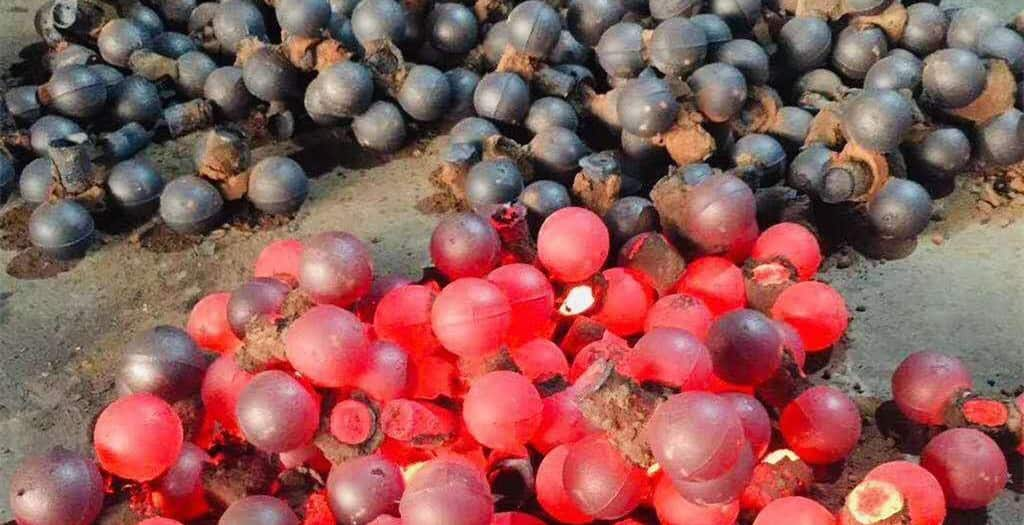Influence of Filling Modes on Blowhole Defects of High Chromium Cast Iron Grinding Ball (2)
3.Analysis and discussion
In the scheme I, the single mold’s sprue and riser are one unit, there are no vent holes, the pouring process is top-pouring type, and the grinding balls metal mold has no air permeability. The molten iron enters the mold cavity through the pouring (riser) port; the gas in the mold cavity can only pass through the pouring (riser) port to discharge out of the mold. However, the pouring speed is controlled by the experience of the pouring workers, and the human factors have a great influence on it. If the casting speed is too fast, the gas in the mold cavity can not be smoothly discharged out of the mold and easily involved in the molten iron, the gas hole defects will be formed in the riser root section of the grinding ball, the surface near the riser or the center of the high chromium grinding ball.
In Plan II, the sprue and riser of a four-ball mould are a whole, each ball has an exhaust hole at the top, and the pouring process is of middle-pouring type. The molten iron enters the mold cavity through the pouring (riser) port, the gas in the mold cavity can not only discharge out of the mold through the pouring (riser) port but also discharge out of the mold through the vent hole above the mold cavity, in this way, it is ensured that the gas in the mold cavity can be discharged out of the mold easily and is not easily involved in the molten iron.
After the molten metal is poured into the mold, the turbulent vortex and a large amount of gas are involved in the pouring process. The charging mode of the scheme I is the top-pouring type, the molten iron enters the cavity directly from the pouring (riser) port, the impact force is bigger, the momentum change of pouring molten iron is bigger, the turbulence phenomenon is more serious, easy to be involved in the gas. The filling mode of Scheme II is the middle-pouring type, the molten iron is poured from the gate (riser), then the molten iron is buffered by the gate, the cavity is poured along the Ingate, the impact force is small, the momentum change of pouring molten iron is small, the turbulence phenomenon is relatively reduced, and the filling is relatively stable, it’s hard to get into the gas.
Suppose the entrained gas floats up in the molten iron in the mould cavity until the riser’s upper surface is exhausted. In that case, no gas hole defect will be formed in the Cross-section of the high chromium grinding ball center or the root of the riser and the surface near the riser, if the upper surface of the riser is drained out and remains in the molten iron, pore defects will be formed on the Cross-section of the center of the grinding ball or the root of the riser and near the surface of the riser. High Chromium cast iron has volume solidification characteristics because of its high chromium content and carbide type (CR, Fe)7C3. Because the width of the solidification zone is very wide when the temperature of molten iron in the mold decreases to the range of solidification temperature, nearly all parts of molten iron begin to form a solid crystal nucleus and grow freely, which makes the dynamic viscosity of Molten iron increase, poor liquidity, the existence of gas in the liquid iron is not easy to float up. Therefore, for the plan I, when the gas in the molten iron has not been completely discharged out of the mold, the surface of the riser of the grinding ball has begun to solidify the shell, preventing the gas from being discharged out of the mold. At this time, the gas in the molten iron is difficult to float up. As a result, the undischarged gas is trapped in the center of the grinding ball, the surface, and the riser, resulting in pore defects.
4.Conclusion
(1) one mold, four-ball mold, using, in the injection type, filling, through the gate (riser), exhaust holes will exhaust gas outside the mold, exhaust capacity is stronger than the top-injection type single mold.
(2) the single die is filled with top-injection mould, the impact force of molten iron is bigger, the turbulence phenomenon is more serious, and it is easy to be involved in gas.
Because of the gate socket’s cushioning effect, the impact force of Molten iron is small, the turbulence phenomenon is relatively reduced, the filling is relatively stable, and it is not easy to be involved in the gas. For High Chromium cast iron grinding ball with (CR, Fe)7C3 carbide type, adopting one mould with four balls can eliminate the porosity defect of the High chromium Grinding Ball, which is superior to a single mould.

